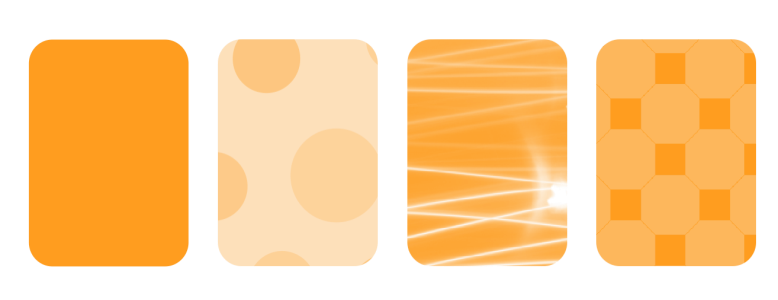
| • | To apply a vector or bitmap pattern transparency |
| • | To modify or create a vector or bitmap transparency |
| • | To apply a two-color pattern transparency |
Vector pattern transparencies are pictures composed of lines and fills, instead of dots of color like bitmaps. These vector graphics are smoother and more complex than bitmap images and are easier to manipulate.
Bitmap pattern transparencies are color pictures composed of patterns of light and dark or differently colored pixels in a rectangular array.
Two-color pattern transparencies are simple pictures composed of "on" and "off" pixels. The only shades included in the picture are the two that you assign.
You can choose pattern transparencies from a personal or shared library. You can browse the available transparency patterns, search by keyword, mark patterns as favorites, and sort patterns. You can also download additional fill packs, which can be used as transparency patterns. For more information, see Finding and viewing fills and transparencies.
You can modify pattern transparencies to suit your needs.
After you modify or create a pattern transparency, you can save it for future use. For more information, see Saving fills and transparencies.
| To apply a vector or bitmap pattern transparency |
|
| 1 . | Select an object. |
| 2 . | Click Edit |
| 3 . | In the Transparency area of the Property manager docker, click one of the following buttons: |
| • | Vector pattern transparency |
| • | Bitmap pattern transparency |
| 4 . | Open the Transparency picker, and double-click a thumbnail. |
| This action applies the transparency and closes the Transparency picker. To apply the transparency without closing the Transparency picker, click the transparency thumbnail. |
For information about how to find transparencies in the Transparency picker, see To find, filter, and sort fills and transparencies.
To apply the transparency only to the fill or the outline of the object, click the Fill button or the Outline button
.
You can also click the Transparency tool in the toolbox and use the controls on the property bar.
| To modify or create a vector or bitmap transparency |
|
| 1 . | Select an object. |
| 2 . | Click Edit |
| 3 . | In the Transparency area of the Property manager docker, click one of the following buttons: |
| • | Vector pattern transparency |
| • | Bitmap pattern transparency |
| 4 . | Click the Edit transparency button |
| 5 . | Perform a task from the following table. |
|
In the Seamless area, click the Radial blend button
|
|
|
Enable the Edge match check box, and move the slider.
|
|
|
Enable the Brightness check box, and move the slider.
|
|
|
Enable the Luminance check box, and move the slider.
|
|
|
Enable the Color check box, and move the slider.
|
|
|
Type values in the Transparency width and Transparency height boxes.
|
|
|
Type values in the X and Y boxes.
|
|
|
Type a value in the Rotate box.
|
|
|
Type a value in the Skew box.
|
|
|
Enable the Transform with object check box.
|
|
|
Click the New source from workspace button
|
|
|
Click the New source from file button
|
To save the edited transparency, click the Save as new button .
You can also change the size of pattern tiles by clicking the Transparency tool , selecting an object, and using the controls on the property bar.
You can also skew or rotate tiles by clicking the Transparency tool , selecting an object, and dragging the skewing or rotation handles to change the appearance of the pattern.
| To apply a two-color pattern transparency |
|
| 1 . | Select an object. |
| 2 . | Click Edit |
| 3 . | In the Transparency area of the Property manager docker, click the Two-color pattern transparency button |
| 4 . | Choose a pattern from the Transparency picker. |
| 5 . | Type values in the Foreground transparency and Background transparency boxes. |
To apply the transparency only to the fill or the outline of the object, click the Fill button or the Outline button
.
To modify the pattern, click the Edit transparency button , and specify the settings you want.
You can also click the Transparency tool in the toolbox and use the controls on the property bar.
Copyright 2018 Corel Corporation. All rights reserved.